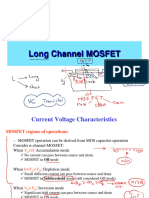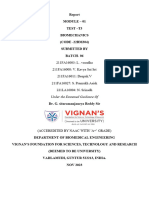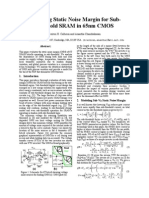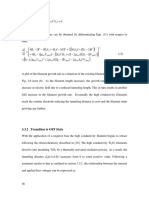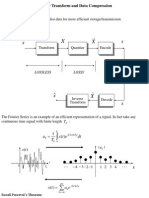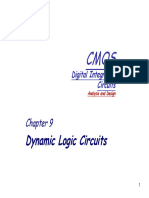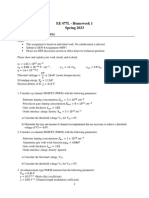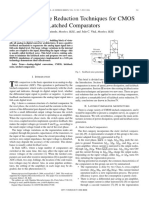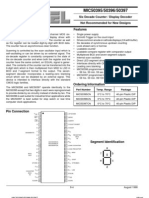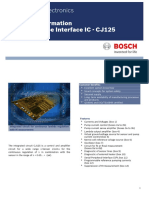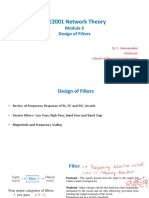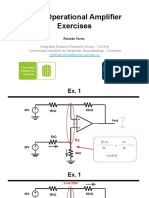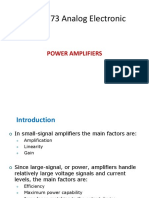Tutorial-1 Low Noise Amplifier (LNA) Design: Complied by Rashad M. Ramzan
Tutorial-1 Low Noise Amplifier (LNA) Design: Complied by Rashad M. Ramzan
Uploaded by
Srinath SrinivasanCopyright:
Available Formats
Tutorial-1 Low Noise Amplifier (LNA) Design: Complied by Rashad M. Ramzan
Tutorial-1 Low Noise Amplifier (LNA) Design: Complied by Rashad M. Ramzan
Uploaded by
Srinath SrinivasanOriginal Title
Copyright
Available Formats
Share this document
Did you find this document useful?
Is this content inappropriate?
Copyright:
Available Formats
Tutorial-1 Low Noise Amplifier (LNA) Design: Complied by Rashad M. Ramzan
Tutorial-1 Low Noise Amplifier (LNA) Design: Complied by Rashad M. Ramzan
Uploaded by
Srinath SrinivasanCopyright:
Available Formats
Spring 2010: Radio Frequency Integrated Circuits (TSEK03) 1/18
Tutorial-1
Low Noise Amplifier (LNA) Design
Complied by Rashad M. Ramzan
Objective:
Low noise amplifiers are one of the basic building blocks of any communication system.
The purpose of the LNA is to amplify the received signal to acceptable levels with
minimum self-generated additional noise. Gain, NF, non-linearity and impedance
matching are four most important parameters in LNA design.
The objective of this tutorial is to outline the basic tradeoffs between different amplifying
topologies w.r.t gain, NF and impedance matching. After this comparison it is concluded
that inductor degenerated common source topology gives the best performance to meet
the gain, NF, and impedance matching goals with minimum power consumption in case
of narrow band designs.
Goals:
After this tutorial, students should be able to
• Calculate the gain, input impedance and NF of common gate, common source,
and shunt feedback amplifiers.
• Understand the basic equations and tradeoff between different LNA topologies.
• Perform the calculation for inductor degenerated common source topology and
understand the tradeoff between the gain, NF, and impedance matching.
A supplement tutorial LNA lab is also part of this course which guides through
different analyses to design a practical LNA.
Electrical Engineering Department (ISY), Linköping University
Spring 2010: Radio Frequency Integrated Circuits (TSEK03) 2/18
Problem-1.1(Tutorial)
NMOS transistor is racing horse in LNA design arena due to its higher mobility compared to
PMOS transistors. Calculate the IP3 of NMOS CS amplifier shown below. Assume that NMOS
transistor is in saturation.
a) Consider simplified square law model. (HW)
Kn
ID = (VGS − VT ) 2
2
b) Consider the short channel effects as:
K n (VGS − VT ) 2
ID =
2 1 + θ (VGS − VT )
θ = Velocity Saturation, Mobility Degradation
VGS − VT = 0.2V and θ = 0.1V −1
Observe that this transistor is not a very “short channel” device as θ << 1.
c) What conclusion can be drawn from part b) about the bias current and transconductance
of the transistor for higher IP3?
Solution:
a). Homework answer: IP3 = ∞ VDD
b). RL
y ( x) = α 0 + α 1 x(t ) + α 2 x 2 (t ) + α 3 x 3 (t ) --------------(1) NMOS
x(t) VGS
4 α1
x(t ) = A cos ω 1 t + A cos ω 2 t ⇒ AIP 3 =
3 α3 DC-bias
Electrical Engineering Department (ISY), Linköping University
Spring 2010: Radio Frequency Integrated Circuits (TSEK03) 3/18
K n (VGS − VT )
2
ID =
2 1 + θ (VGS − VT )
Here we assume a small signal x(t) around the bias (VGS – VT), so
K [(VGS − VT ) + x(t )]
2
ID = n
2 1 + θ (VGS − VT + x(t ))
we define VGS − VT = ∆V --------------- Bias voltage
K
ID = n
[x(t ) + ∆V ] 2
--------------------------------------------------------------(2)
2 θ ( x(t ) + ∆V ) + 1
K R ( x(t ) + ∆V )
2
K n RL
Vo = I D RL ⇒ Vo = n L and we put =K
2 1 + θ ( x(t ) + ∆V ) 2
1 ρ
θ << 1 so (x(t ) + ∆V ) is also small ⇒
1+ ρ
= 1−
2
1 θ ( x(t ) + ∆V )
≈1−
1 + θ ( x(t ) + ∆V ) 2
2 θ ( x(t ) + ∆V )
Vo = K ( x(t ) + ∆V ) 1 −
2
3 Kθ
Vo = K ( x(t ) + ∆V ) − ( x(t ) + ∆V )
2
2
Kθ 3 Kθ
V o = K ∆V 2 − ∆V 3 + 2 K ∆V − ∆V 2 x (t )
2 2
3 Kθ Kθ 3 -----------------------------(3)
+K − ∆ V x 2 (t ) − x (t )
2 2
Comparing (1) & (3)
3 Kθ 3 Kθ Kθ
α1 = 2 K∆V − ∆V 2 , α 2 = K − ∆V , α3 = −
2 2 2
3
2 K∆v − Kθ∆V 2
4 α1 4 2 8 2∆V
AIP 3 = = × = − 3∆V 2
3 α3 3 Kθ 3 θ
2
8 2 ∆V 16 ∆V As θ << 1 3∆V can be ignored.
2
AIP 3 = =
3 θ 3 θ
Electrical Engineering Department (ISY), Linköping University
Spring 2010: Radio Frequency Integrated Circuits (TSEK03) 4/18
16 ∆V 16 (VGS − VT )
AIP 3 = =
3 θ 3 θ -------------------------------(4)
Please, note that this formula only holds for small value of θ.
A large gate bias voltage (VGS – VT) improves IP3.
Put ∆V = 0.2V, θ = 0.1 V -1
16 0.2
AIP 3 = = 3.27Volts
3 0 .1
3.27 2 1
IIP3(dBm) = 10 log . 1mW ≅ 20dBm
2 50
K (VGS − VT )
2
c). From ID = n the NMOS transconductance can be found as
2 1 + θ (VGS − VT )
K n (VGS − VT )(2 + θ (VGS − VT ) )
gm =
2 (1 + θ (VGS − VT ))2 .
By comparison of those two formulas we find
ID 1 + θ (VGS − VT ) VGS − VT
= (VGS − VT ) × ≅
gm 2 + θ (VGS − VT ) 2
and hence, (4) can be rewritten as
32 I D
AIP 3 ≅
3θ g m
As shown, IIP3 is decided by the ratio ID/gm which is constant for a given gate bias voltage.
Using e.g. a wider transistor does not change this ratio and only the power consumption
is increased.
Problem-1.2 (Tutorial)
It is preferred in current RF designs that the input of LNA be matched to 50 Ω. The easiest way is
to shunt the gate with a resistor of 50 Ω.
a) Calculate the gain, input impedance and NF in absence of gate noise. Assume that Rsh=RL
for NF derivation.
b) What are the disadvantages of shunt resistor with reference to gain and NF?
Electrical Engineering Department (ISY), Linköping University
Spring 2010: Radio Frequency Integrated Circuits (TSEK03) 5/18
Solution:
a). (Please read assumption in the problem statement carefully)
VDD
V 2 n , Rs Rs G D Vout RL
Rsh Rs Vout
V 2
n , Rsh
gmVgs i2d RL Vin
Rsh
S Zin
RL is noiseless (Biasing not shown)
Total output noise power
F=
Output noise due to input source
V 2 m , Rs = 4kTRs ∆f Gain Gate = − g m RL
Rsh
V 2 m ,Rsh = 4kTRsh ∆f A = g m RL for Rsh = Rs
R
s + R sh
RL
i 2 d = 4kTγg m ∆f A = −gm
2
Using superposition, considering one at a time and shorting / opening other sources.
2
Rsh
= V n , Rs × g m RL ×
2 2 2 2
V on , Rs
R
s + R sh
2
Rs
= V n , Rsh × g m RL ×
2 2 2 2
V on , Rsh
R
s + R sh
Electrical Engineering Department (ISY), Linköping University
Spring 2010: Radio Frequency Integrated Circuits (TSEK03) 6/18
V 2 no,d = i 2 d × R 2 L
V 2 on , Rs + V 2 on, Rsh + V 2 no ,d V 2 on , Rsh + V 2 o ,d
F= =1+
V 2 on , Rs V 2 on ,Rs
g 2 m R 2 L × R 2 sh
4kTRsh ∆f ×
(Rs + Rsh )2 4kTγg m ∆f × R 2 L
F =1+ +
g 2m R2L × R2s g 2m R2L × R2s
4kTRs ∆f × 4 kTR ∆f ×
(Rs + Rsh )2 S
(Rs + Rsh )2
In case of impedance match Rs = Rsh
R L2 γ g m R L2 γ g m 4γ
F = 1+1+ = 2 + = 2 +
g 2 R2 × R2 g 2 × R L2 g m Rs
Rs × m S 2 L Rs × m
4RS 4
b).
- Poor Noise Figure
- Input signal attenuated by voltage divider
- Rsh adds extra noise.
- At high frequency, shunt L is needed to tune out Cgs
- Reduced gain.
Problem-1.3 (Tutorial)
Another approach to get 50 Ω input impedance match is shunt feedback amplifier shown below.
a) Calculate the gain, input impedance and NF neglecting the gate noise. The gate-drain,
gate-bulk, and gate-source capacitance can be neglected as well.
b) What are the disadvantage of shunt feedback amplifier with reference to gain and NF?
Electrical Engineering Department (ISY), Linköping University
Spring 2010: Radio Frequency Integrated Circuits (TSEK03) 7/18
Solution:
VDD
2
Rs V n , RF
RF Vout
RF RL
Rs Vout
V 2 n , Rs gmVgs I 2 nD RL
Vin
Zin
(Equivalent noise model ignoring gate noise), RL is noiseless (Biasing not shown)
I 2 nD = 4kTγg m ∆f ,V 2 RS = 4kTRS ∆f
V 2 n , out Total input noise power
F= =
A 2 v , tot V 2 RS Output noise power due to input source
Here Av,tot = Gain from Vin to Vout
Again using superposition theorem
+ Vn + Vn
2 2 2
V 2 n ,out Vn
F= =
RS , out RF , out D , out
A 2 v ,tot V 2 RS A 2 v ,tot V 2 RS
Gain Calculation
Vin = iin (RS + RF ) + Vout
Vout = (iin − g mVgs )RL Iin RF Vout
Rs
Vgs = iin RF + Vo Iin RL
Vout RL (1 − g m RL )
Av ,tot = =
Vin RS + RF + RL + g m RS RL
If RF>>RS & gmRF>>1
− g m RL iin Rs RF Vout
Av ,tot = ≅ − g m RL
RS 1 + g m RS
+ 1 + RL +
RF RF Vin Vgs gmVgs RL
Av ,tot ≅ − g m RL
RF + RL
Also Z in =
1 + g m RL
By ignoring Cgs, we have considered real part only.
Electrical Engineering Department (ISY), Linköping University
Spring 2010: Radio Frequency Integrated Circuits (TSEK03) 8/18
For source resistance
V 2 nRS ,out = A 2 v ,tot V 2 nRS ---------------(1)
For feedback resistance
2
i Rs RF V RF
V 2 RF ,out
Vgs gmVgs RL
Vgs = −iRS = iRF − VRF + VRF ,out
VRF ,out = RL (i − g mVgs )
1 RL
VRF ,out = VRF = VRF (1 + g m RS )
RS + R F RF
1+
RL (1 + g m Rs )
2
R
V 2
n , RF ,out = V n , RF L (1 + g m RS )
2
---------------------(2)
RF
Similarly
i Rs RF V 2 nD ,out
Vgs gmVgs I 2 n,D RL
VnD ,out VnD ,out
+ I nD + g mVgs + =0
RL RS + R F
VnD ,out
Vgs = RS
RS + R F
I n,D
VnD ,out = ≈ I nD RL
1 1 g R
+ + m S
R L RS + R F RS + R F
So,
V 2 nD ,out = I 2 nD RL
2
------------------------------------------(3)
Combaining (1) (2) & (3)
Electrical Engineering Department (ISY), Linköping University
Spring 2010: Radio Frequency Integrated Circuits (TSEK03) 9/18
2
R
V 2 n , RF L (1 + g m R S )
RF I 2 nD R 2 L
F = 1+ +
A 2 v ,tot V 2 n , RS A 2 v ,tot V 2 n , RS
Av ,tot = − g m RL , V 2 n , RS = 4kTRS ∆f , V 2 M ,RF = 4kTRF & I 2 nD = 4kTγg m
2
R 1 γ
F = 1+ S 1 + +
RF g m RS g m RS
b).
NF ↓ gmRS ↑ & RF ↑ usually RS = 50Ω
- Better performance than CS amplifier
- RF induces noise
- At higher f ↑ a shunt inductor needed to tune out Cgs
- Broadband Amp @ Lower frequency
- To make NF ↓ RF > RS and gmRS >> 1
Problem-1.4 (HW)
Common gate amplifier also offers 50 Ω input impedance match and solves the input matching
problem.
c) Calculate the gain, input impedance and NF in absence of gate noise. Neglect gate drain
and gate to bulk and gate to source capacitance.
a) What are the disadvantage of common gate amplifier with reference to gain and NF?
Problem-1.5 (Tutorial)
The disadvantages of the amplifiers discussed in Problem-2, 3 & 4 can be circumvented by using
the source degenerated LNA shown below.
Electrical Engineering Department (ISY), Linköping University
Spring 2010: Radio Frequency Integrated Circuits (TSEK03) 10/18
a) Calculate the input impedance. This inductor source degenerated amplifier presents a
noiseless resistance for 50Ω for input power match. How we can cancel the imaginary
part of complex input impedance so that the LNA presents 50Ω real input resistance at
input port.
b) Calculate the NF in absence on gate noise. Neglect gate drain and gate to bulk and gate to
source capacitance.
c) Cgd bridges the input and output ports. The reverse isolation of this LNA is very poor.
Why reverse isolation is important? Suggest the modification to improve reverse
isolation.
Solution:
a).
VDD
Rs Lg iin io Vout
VS
RL
gmVgs Vout
Rs Lg
Zin Vin VS
Vgs Ls
Ls
(Biasing not shown)
From model above we can write
1
Vin = iin ( jωLg + jωLs ) + iin + io jωLs ---------------(1)
jωc
1
io = g mVgs = g m iin × --------------------------------------(2)
jωC gs
Substituting (2) in (1)
g L
Vin = iin jω (Lg + Ls ) +
1
+ m s
jωC gs C gs
Electrical Engineering Department (ISY), Linköping University
Spring 2010: Radio Frequency Integrated Circuits (TSEK03) 11/18
= jω (Lg + Ls ) +
Vin 1 g L
Z in = + m s
iin jωC gs C gs
Z in = jω (Lg + Ls ) +
1 g L
+ m s
jωC gs C gs
For matching Lg + Ls are canceled out by Cgs. So at frequency of interest
ωo (Lg + Ls ) =
1 1
⇒ ωo =
2
ωo C gs (Lg + Ls )C gs
gm
And RS = 50Ω = Ls
C gs
Notes:
a). Ls is typically small and may be realized by the bond wire for source.
b). Lg can be implemented by spiral/external inductor.
b).
From part a) Reference:
For series RLC Circuit
Z in = jω (Lg + Ls ) +
1 g L
+ m s
jωC gs C gs R L
We can draw this circuit as Vin C VC
Rs Lg + Ls
Ls 1 L ωo L 1
gm Qs = = =
Vin Zin C gs Cgs Vgs R C R ωo RC
and VC = QSVin
Here
ω o (L g + L s ) ω o (L g + L s )
Q in = =
g m LS R S + ω T LS
RS +
C gs
gm
Q ωT ≅ frequency of current gain equal 1
C gs
1 g m LS
Qin = for match load RS =
g m LS C gs
ωo RS + C gs
C gs
Electrical Engineering Department (ISY), Linköping University
Spring 2010: Radio Frequency Integrated Circuits (TSEK03) 12/18
1
Qin =
2ω o Rs C gs
Gain
Vgs = QinVin Vout
Rs Lg
I
g m = out Vgs RL
V gs Vin Ls
Zin
I out V gs g m
Gm = = = Qin g m
V in V in
G m = Qin g m
V out
so, = −G m R L where Gm = Qin g m
Vin
Noise Figure:
Total noise power at output
F=
noise power at output due to input source
For this calculation we ignore channel noise.
V 2 nRS ,OUT + V 2 nD ,OUT V 2 nD ,OUT
F= =1+
V 2 nRS ,OUT V 2 nRS ,OUT
V 2 nD ,OUT = i 2 n ,D R 2 L i 2 n , D = 4kTγg m ∆f
V 2 nRS ,OUT = V 2 n ,RS G 2 m R 2 L V 2 n , RS = 4kTRS ∆f & Gm = Qin g m
i n2, D R L2
F = 1+ i 2 n , D = 4kTγg m , V 2 n , RS = 4kTRS
2 2 2 2
V n , RS Q g R
in m L
γ
F = 1+
g m R S Qin2
Notes:
- Very good NF value
- Narrow band matching
- NF ↓ with Q 2
- The Q is dependent upon Lg + Ls, Ls usually small so Q depends mainly upon Lg
Electrical Engineering Department (ISY), Linköping University
Spring 2010: Radio Frequency Integrated Circuits (TSEK03) 13/18
C). Drawbacks
i).
VDD VDD
RL generates noise so replace
RL LD CL
RL with LD so that’s
Rs Lg Vout 1 Rs Lg
VS ωo = VS
LD C L
Ls Ls
The CL can be considered the input capacitance of the following mixer or filter.
VDD
ii).
LD CL
Reverse Isolation Cgd
Vb
Vout Rs Lg
Ls
Lo
(Final Design)
Reverse isolation depends upon capacitance between output and input.
To make it less the cascode architecture can be used.
Problem-1.6 (HW)
Fill-in the Table below, use the data from Problem-1.2, 1.4, 1.3 and 1.5
Type of LNA Zin Noise Factor Gain NF (dB)
Shunt Resistor Rsh 4γ − g m RL
2+
g m RS 2
Common Gate
Shunt Feedback
Source Degenerated
Electrical Engineering Department (ISY), Linköping University
Spring 2010: Radio Frequency Integrated Circuits (TSEK03) 14/18
a) Calculate the NF for all above amplifiers. Assume γ=2, gm = 20mS, Rs = 50Ω, RF =
500Ω, and Qin = 2.
b) Which is the best topology for Narrow Band LNA design at high frequency?
Problem-1.7 (Tutorial)
Real Design: We will design the inductor-source-degenerated LNA shown in Fig below to meet
the specification outlined for IEEE802.11b standard. The first cut approximate values are
calculated as a starting point for simulation.
LNA Specification:
NF < 2.5 dB, Gain > 15dB, IIP3 > -5dBm, Centre Frequency = 2.4 GHz
Load Capacitance = 1pF
Technology Parameters for 0.35um CMOS:
Leff = 0.35µ m, µ n Cox = 170 µ A V 2 , Cox = 4.6 mF m2 , µ p Cox = 58 µ A V 2 , γ = 2
δ = 4, C = 0.395, α = 0.85
Solution:
µ o Cox = 170 µA V 2 , µ p Cox = 58 µA V 2 ,
Technology 0.35µm CMOS:
Cox = 4.6 mF m , γ = 2, Leff = 0.35µm
2
δ = 4, C = 0.395, α = 0.85
Design Parameters
NF < 2.5 dB, Gain > 15dB, IIP3 > -5dBm, f0 = 2.4 GHz
Electrical Engineering Department (ISY), Linköping University
Spring 2010: Radio Frequency Integrated Circuits (TSEK03) 15/18
VDD
RREF LD
M3 M2
RBIAS Vout
Lg
M1
RS CB CL = 10pF
Vin Ls
Component Description
Ls – Matches input impedance
Lg – Sets the Resonant Frequency fO = 2.4 GHz
M3 – Biasing transistor which forms current mirror with M1
Ld – Tuned output increases the gain and also work as band pass filter with CL
M2 – Isolates tuned input from output to increase reverse isolation, also reduces the effect of
Miller capacitance Cgd
CB – BC blocking capacitor chosen to have negligible reactance at fO = 2.4 GHz
RBIAS – Large enough so that its equivalent current noise is small enough to be ignored. (Don’t
consider it as voltage noise source. Why??)
Design Procedure
Size of M1:
From the noisy two-port theory (see the course book or lecture notes) the optimal input matching
and minimum noise figure is given by:
Gopt = αω C gs
δ
5γ
(
1− C =
2 1
50Ω
) ----------------------(A)
Fmin = 1 +
2 ω
5 ωT
(
γC 1 − C
2
) = 1 + 2.3 ωω -------(B)
T
From (A)
C gs ≅ 2.7 pF ⇒ WM 1 ≈ 3C gs / 2COX Leff ≈ 2.5mm ( not feasible – huge size, huge
power ! )
Conclusion: We will not go for the global minimum noise figure. Instead, we will look into the
constraint power design approach.
Solution:
LNA NF will be optimized for given power which is higher than the global minimum NF.
Electrical Engineering Department (ISY), Linköping University
Spring 2010: Radio Frequency Integrated Circuits (TSEK03) 16/18
In this case the optimum transistor width is given by:
1
Wopt =
3ωo Leff Cox RS
while the minimum power-constraint NF :
γ ω ω
Fmin, p = 1 + 2.4 ⇒ Fmin, p = 1 + 5.6 ---------------(C)
α ωT ωT
(B) is the global minimum noise figure.
(C) is the minimum NF for a given power consumption.
In practice the difference is usually 0.5dB to 1dB (no big deal for Lower Power)
Step - 1:
I1 = I 2 = 5mA (Limited Power consumption)
Step - 2:
1
WM 1 =
3ω 0 L eff C ox R S
RS = 50Ω, Cox = 4.6 mF m 2 ,
1
WM 1 = µ n Cox = 170 µA V , Leff = 0.35µm,
3 × 0.35µ × 4.6m × 50 × ωo ω = 2πf , f = 2.4GHz
o o o
WM 1 = 3.9 × 10 −4
WM 1 = 3.9 × 10 −4 = 390µm
Step - 3:
2
C gs1 = WM 1 Leff Cox
3
2
C gs1 = × 390µ × 0.35µ × 4.6m = 0.41 pF
3
W 2 I DM 1
g m1 = 2 µ n C ox I DM 1 g m1 =
L M1 or V GS − VT (for short channel model)
390
g m1 = 2 × 170µ × × 5m = 43 mA V
0.35
Electrical Engineering Department (ISY), Linköping University
Spring 2010: Radio Frequency Integrated Circuits (TSEK03) 17/18
g m1 43 mA V
ωT ≈ = = 104G rad Sec
C gs1 0.41 pF
Assuming γ =2
ωo
Now Fmin = 1 + 5.6
ωT
2π 2.4G
Fmin = 1 + 5.6 ≈ 2.55dB
104G
NF ≈ 2.55dB
This NF is very close to the specified value. If we increase ID then ωT should increase slightly as
well and hence, a lower NF value can be achieved at expense of more power.
Step - 4:
Source and gate inductance such that they cancel Cgs and set 50Ω input impedance
ωo = 2πf o = 2π 2.4 = 15G rad Sec
From previous problem
g m LS
R S = RTransformed = ≅ ω T LS
C gs
RS 50
LS = = ≅ 0.5nH
ωT 100G
LS = 0.5nH can be implemented using the bond wire.
1
L + L =
Now
ω 02 C gs1
g s
1
Lg + Ls = = 10.81nH
(15G ) × 0.41 pF
2
Lg ≈ 10nH
Step - 5:
1
Ld = Q C L = 1 pF
ωo 2C L
1
Ld = ≅ 4.4nH
(15G ) × 1 pF
2
Ld = 4.4nH
Electrical Engineering Department (ISY), Linköping University
Spring 2010: Radio Frequency Integrated Circuits (TSEK03) 18/18
Step - 6:
Size of M3 is chosen to minimize power consumption
W M 3 = 70µm, R REF = 2kΩ ⇒ I 3 = 0.6mA
R BIAS = 2kΩ (Large enough so that it’s equivalent current noise can be neglected)
1
C B = 10 pF ( X C ≈ 6.6Ω so good value @ 2.4G XB = = 6.6Ω )
2πf o C B
Step - 7:
Size M2 = M3
So that they can have shared Drain Area..
(Note: You will simulate same LNA circuit in LAB # 2)
Electrical Engineering Department (ISY), Linköping University
You might also like
- Task 1 - Power Source Unit Implementation You Are A...Document3 pagesTask 1 - Power Source Unit Implementation You Are A...Zulqarnain KhanNo ratings yet
- Homework 5Document24 pagesHomework 5gabriel toro bertel50% (4)
- StochasticDocument3 pagesStochasticDan RusherNo ratings yet
- Chapter (5) Part (2) (Long Channel MOSFET)Document22 pagesChapter (5) Part (2) (Long Channel MOSFET)Ahmed SalehNo ratings yet
- Physics 385 Assignment 7: Problem 8-3Document5 pagesPhysics 385 Assignment 7: Problem 8-3wizbizphdNo ratings yet
- Tutorial-1 Low Noise Amplifier (LNA) Design: by Rashad.M.Ramzan Rashad@isy - Liu.se ObjectiveDocument18 pagesTutorial-1 Low Noise Amplifier (LNA) Design: by Rashad.M.Ramzan Rashad@isy - Liu.se ObjectiveRakesh Rt100% (1)
- Adc IeeeDocument4 pagesAdc IeeeKavya Sai sriNo ratings yet
- Simplest Working Example LaTeX Document-1Document5 pagesSimplest Working Example LaTeX Document-1Soumyadip MondalNo ratings yet
- V2 Dijkstra LayoutDocument40 pagesV2 Dijkstra LayoutcalpostigoNo ratings yet
- Experiment No1Document11 pagesExperiment No1Ritwik RoyNo ratings yet
- 1 Eamta12 - 1Document14 pages1 Eamta12 - 1Kerubiel AnikkuNo ratings yet
- Ese Mains Paper 1 Q S 42Document55 pagesEse Mains Paper 1 Q S 42bt2O1O5131 AnshulNo ratings yet
- PHY2606_TL203_0_2024Document10 pagesPHY2606_TL203_0_2024Wikus SandersNo ratings yet
- MT1 Problem - Component ClassificationDocument1 pageMT1 Problem - Component Classificationyigitatmaca2316ymNo ratings yet
- Equations ME45001-2324Document2 pagesEquations ME45001-2324Lennarth OnbekendNo ratings yet
- Analyzing Static Noise Margin For Sub-Threshold SRAM in 65nm CMOSDocument4 pagesAnalyzing Static Noise Margin For Sub-Threshold SRAM in 65nm CMOSBhavana ChaurasiaNo ratings yet
- Chapter 10Document21 pagesChapter 10StefanPerendijaNo ratings yet
- 08 Differential Equations - Second Order LDE ApplicationsDocument25 pages08 Differential Equations - Second Order LDE ApplicationsRemo Rubian EvangelistaNo ratings yet
- Ece2610 Chap3Document46 pagesEce2610 Chap3jagriti kumariNo ratings yet
- Analog Communication - AM ModulatorsDocument5 pagesAnalog Communication - AM ModulatorsB.Prashant JhaNo ratings yet
- Supplementary For Security ProofDocument4 pagesSupplementary For Security ProofSpider JockeyNo ratings yet
- Et M Zulassungspruefung PDFDocument5 pagesEt M Zulassungspruefung PDFmuhammad bilalNo ratings yet
- Mit8 044S13 L19 PDFDocument26 pagesMit8 044S13 L19 PDFLisaNo ratings yet
- Mit NotesDocument26 pagesMit NotesLisaNo ratings yet
- ES2A7 - Fluid Mechanics Example Classes Example Questions (Set IV)Document8 pagesES2A7 - Fluid Mechanics Example Classes Example Questions (Set IV)Alejandro PerezNo ratings yet
- 5 L L EC533: Digital Signal Processing: DFT and FFTDocument20 pages5 L L EC533: Digital Signal Processing: DFT and FFTDalia Abou El MaatyNo ratings yet
- Tugas - 1 - PSPK Firstiando YudaDocument10 pagesTugas - 1 - PSPK Firstiando YudaBrayonoFlo100% (1)
- Memristors 61 70Document10 pagesMemristors 61 70Tamas ZefferNo ratings yet
- 07 - Telegrapher EquationDocument9 pages07 - Telegrapher EquationSaddam HusainNo ratings yet
- Full Test-4Document10 pagesFull Test-4goksa7322No ratings yet
- Course 18.327 and 1.130 Wavelets and Filter BanksDocument11 pagesCourse 18.327 and 1.130 Wavelets and Filter Banksdjoseph_1No ratings yet
- Fourier Transform and Data CompressionDocument8 pagesFourier Transform and Data CompressionBugi WibowoNo ratings yet
- Adc Ieee Batch 06Document4 pagesAdc Ieee Batch 06Kavya Sai sriNo ratings yet
- Lecture5 MaterPhysII PrecipitationDocument27 pagesLecture5 MaterPhysII PrecipitationBaha JawadNo ratings yet
- C_examADTrans-2223-1SDocument6 pagesC_examADTrans-2223-1Sliamanalieva54No ratings yet
- EE05321Notes 8Document6 pagesEE05321Notes 8Sanapala RAJENDRA PRASADNo ratings yet
- ECE GATE 2021 February 7 3 PM Converted 1Document5 pagesECE GATE 2021 February 7 3 PM Converted 12512bindumadhaviNo ratings yet
- Chapter 9. Transmission LinesDocument28 pagesChapter 9. Transmission Lines채정우No ratings yet
- Pspice MOSFETDocument13 pagesPspice MOSFETHiba TouneNo ratings yet
- Chapter 9Document48 pagesChapter 9AbhaylholkarNo ratings yet
- Tut 01Document39 pagesTut 01huhuivory29No ratings yet
- 4.3 2-D Discrete Cosine Transforms: N N K N N K N N X K K XDocument19 pages4.3 2-D Discrete Cosine Transforms: N N K N N K N N X K K Xnayeem4444No ratings yet
- Threshold Voltage MosfetDocument6 pagesThreshold Voltage MosfetsantoshineepandaNo ratings yet
- Task 3 Marco Cesar 203058 48Document12 pagesTask 3 Marco Cesar 203058 48asesorias academicasNo ratings yet
- EELE44514_L25-27prelimDocument24 pagesEELE44514_L25-27prelimorangepi5abcNo ratings yet
- EE477L HW1 Sp23Document3 pagesEE477L HW1 Sp23ruweiyanNo ratings yet
- 1 Synchronization and Frequency Estimation Errors: 1.1 Doppler EffectsDocument15 pages1 Synchronization and Frequency Estimation Errors: 1.1 Doppler EffectsRajib MukherjeeNo ratings yet
- Homework6 SolutioncDocument4 pagesHomework6 SolutioncRiajimin0% (1)
- Band GapDocument15 pagesBand GapMoin PashaNo ratings yet
- Lec 2Document4 pagesLec 2Mohit KumarNo ratings yet
- 19 - Capacitance Contribution To Synchronous Buck Converter LossesDocument5 pages19 - Capacitance Contribution To Synchronous Buck Converter LossesWesley de PaulaNo ratings yet
- Handout 11Document9 pagesHandout 11djoseph_1No ratings yet
- 2012 Gate EC Solved Paper PDFDocument50 pages2012 Gate EC Solved Paper PDFhelopixu100% (1)
- Sinusoids and PhasorsDocument12 pagesSinusoids and PhasorsNaufal NasiriNo ratings yet
- Akhil Math IA Properties of AC CircuitsDocument12 pagesAkhil Math IA Properties of AC CircuitsJordy Van KollenburgNo ratings yet
- Saturated LoadDocument9 pagesSaturated Loadsany6354No ratings yet
- Bài Báo Cáo 1 - PH1026Document3 pagesBài Báo Cáo 1 - PH1026son caoNo ratings yet
- Green's Function Estimates for Lattice Schrödinger Operators and ApplicationsFrom EverandGreen's Function Estimates for Lattice Schrödinger Operators and ApplicationsNo ratings yet
- Feynman Lectures Simplified 2C: Electromagnetism: in Relativity & in Dense MatterFrom EverandFeynman Lectures Simplified 2C: Electromagnetism: in Relativity & in Dense MatterNo ratings yet
- Floating ResistorDocument6 pagesFloating Resistorrahul shiv shankarNo ratings yet
- A Technical Seminar Report 19q91a0429 Ece ADocument32 pagesA Technical Seminar Report 19q91a0429 Ece ASushmaNo ratings yet
- TestDocument25 pagesTestsubha4studyNo ratings yet
- Kickback NoiseDocument5 pagesKickback Noisekijiji userNo ratings yet
- Ldco Insem BankDocument2 pagesLdco Insem BankShivamNo ratings yet
- RF/Microwave Oscillator: Sindhudurg Shikshan Prasarak Mandal's College of Engineering, Kankavali, Maharashtra, IndiaDocument22 pagesRF/Microwave Oscillator: Sindhudurg Shikshan Prasarak Mandal's College of Engineering, Kankavali, Maharashtra, IndiaNabeel KarvinkarNo ratings yet
- DatasheetDocument6 pagesDatasheetUlma HudinNo ratings yet
- Network Theory: Presented byDocument29 pagesNetwork Theory: Presented bySapata KumarNo ratings yet
- Power Electronics Question Paper EC-604Document2 pagesPower Electronics Question Paper EC-604Jayesh JoshiNo ratings yet
- NC7WZ07 ONSemiconductorDocument11 pagesNC7WZ07 ONSemiconductorsanchezmartellsNo ratings yet
- DDS Function GeneratorDocument3 pagesDDS Function GeneratorjckworldNo ratings yet
- 1000 MEQs - COA & DL 100Document218 pages1000 MEQs - COA & DL 100Dutta Computer AcademyNo ratings yet
- Lijst 4000 CMOS Logische ICsDocument7 pagesLijst 4000 CMOS Logische ICsMawunyoNo ratings yet
- DPSKDocument3 pagesDPSKరాహుల్ దేవ్No ratings yet
- Crosstalk and NoiseDocument18 pagesCrosstalk and NoisepajayakNo ratings yet
- Getting Started With STM32F37/38xxx SDADC (Sigma-Delta ADC) : Application NoteDocument24 pagesGetting Started With STM32F37/38xxx SDADC (Sigma-Delta ADC) : Application NotemowsongNo ratings yet
- Expt 1Document9 pagesExpt 1PRINCESS JAMIE ARAH GALIASNo ratings yet
- VHDL Code For 4 Bit Synchronous CounterDocument8 pagesVHDL Code For 4 Bit Synchronous CounterPawan PariharNo ratings yet
- Muhammad Jawad Shakil 20i-1316: Lab TutorialDocument10 pagesMuhammad Jawad Shakil 20i-1316: Lab TutorialJafar HussainNo ratings yet
- IV-i Question Bank (r15)Document82 pagesIV-i Question Bank (r15)kd17209No ratings yet
- CJ125 Product InfoDocument7 pagesCJ125 Product InfoRogério NevesNo ratings yet
- 8284 Clock Generator + Bus Cycles: Presented By: Dr. Syed Aqeel HaiderDocument18 pages8284 Clock Generator + Bus Cycles: Presented By: Dr. Syed Aqeel HaiderHunain RazaNo ratings yet
- Logic Gates With Boolean FunctionsDocument24 pagesLogic Gates With Boolean FunctionsSashi GamageNo ratings yet
- Yuan 2016Document11 pagesYuan 2016Ahmed ShafeekNo ratings yet
- Eee2001 NT Module 6 l1Document7 pagesEee2001 NT Module 6 l1akshata bhatNo ratings yet
- Datasheet1 PDFDocument4 pagesDatasheet1 PDFMuhamad Nuriz BahroniNo ratings yet
- Ideal Operational Amplifier ExercisesDocument10 pagesIdeal Operational Amplifier Exercisesjulio sanchezNo ratings yet
- Electronic CircuitsDocument1 pageElectronic Circuitsajuklm88No ratings yet
- KKKL2173 - Power AmplifierDocument49 pagesKKKL2173 - Power AmplifierAmir MustakimNo ratings yet



